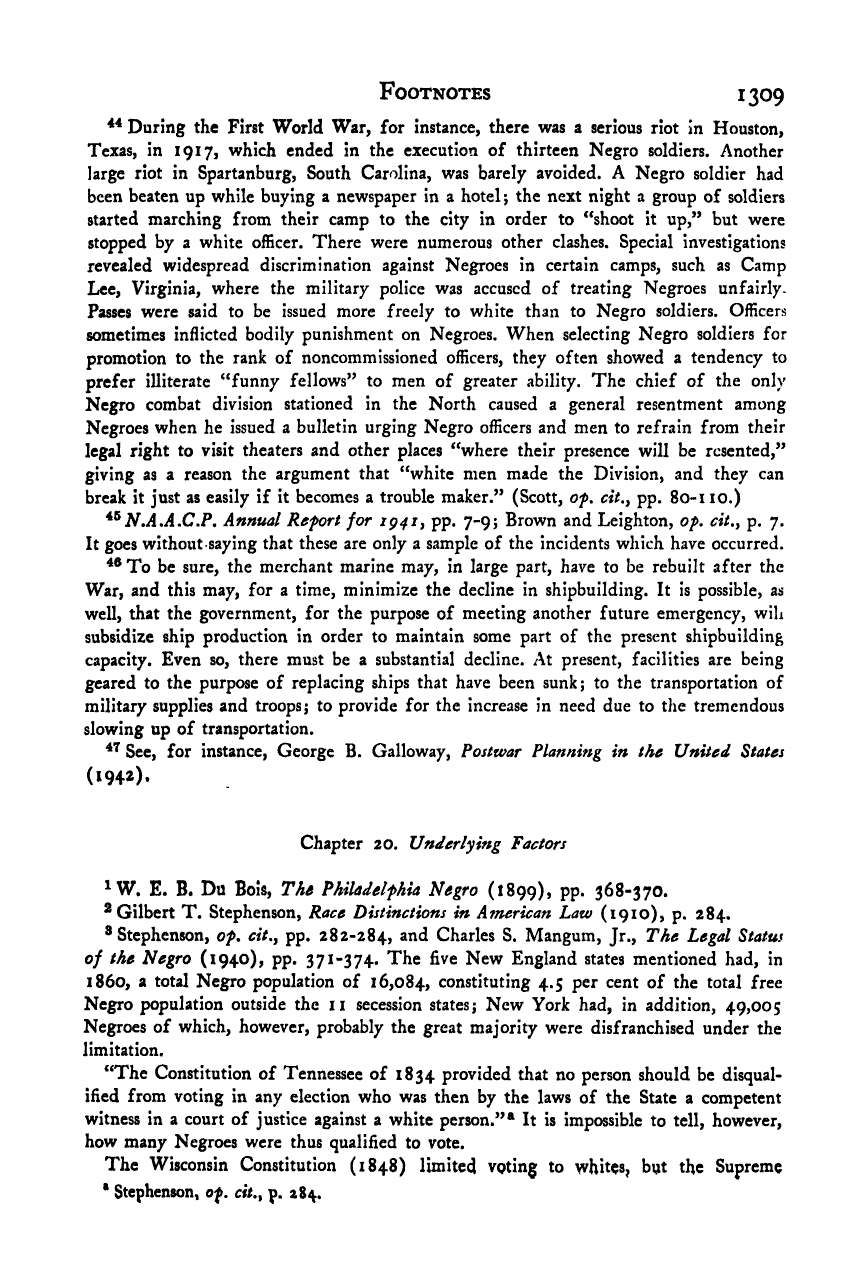Note: Gunnar Myrdal died in 1987, less than 70 years ago. Therefore, this work is protected by copyright, restricting your legal rights to reproduce it. However, you are welcome to view it on screen, as you do now. Read more about copyright.
Full resolution (TIFF) - On this page / på denna sida - Footnotes - Chapter 19 - Chapter 20

<< prev. page << föreg. sida << >> nästa sida >> next page >>
Below is the raw OCR text
from the above scanned image.
Do you see an error? Proofread the page now!
Här nedan syns maskintolkade texten från faksimilbilden ovan.
Ser du något fel? Korrekturläs sidan nu!
This page has never been proofread. / Denna sida har aldrig korrekturlästs.
Footnotes 1309
During the First World War, for instance, there was a serious riot in Houston,
Texas, in 1917, which ended in the execution of thirteen Negro soldiers. Another
large riot in Spartanburg, South Carolina, was barely avoided. A Negro soldier had
been beaten up while buying a newspaper in a hotel; the next night a group of soldiers
started marching from their camp to the city in order to ‘‘shoot it up,” but were
stopped by a white officer. There were numerous other clashes. Special investigations
revealed widespread discrimination against Negroes in certain camps, such as Camp
Lee, Virginia, where the military police was accused of treating Negroes unfairly.
Passes were said to be issued more freely to white than to Negro soldiers. Officers
sometimes inflicted bodily punishment on Negroes. When selecting Negro soldiers for
promotion to the rank of noncommissioned officers, they often showed a tendency to
prefer illiterate “funny fellows” to men of greater ability. The chief of the only
Negro combat division stationed in the North caused a general resentment among
Negroes when he issued a bulletin urging Negro officers and men to refrain from their
legal right to visit theaters and other places “where their presence will be resented,”
giving as a reason the argument that “white men made the Division, and they can
break it just as easily if it becomes a trouble maker.” (Scott, of, cit,y pp. 80- 1 lO.)
N,A,A,C,P, Annual Refort for ig 4 iy pp. 7-9; Brown and Leighton, of, cit,y p. 7.
It goes without -saying that these are only a sample of the incidents which have occurred.
^®To be sure, the merchant marine may, in large part, have to be rebuilt after the
War, and this may, for a time, minimize the decline in shipbuilding. It is possible, as
well, that the government, for the purpose of meeting another future emergency, wih
subsidize ship production in order to maintain some part of the present shipbuilding
capacity. Even so, there must be a substantial decline. At present, facilities are being
geared to the purpose of replacing ships that have been sunk; to the transportation of
military supplies and troops; to provide for the Increase in need due to the tremendous
slowing up of transportation.
See, for instance, George B. Galloway, Postwar Planning in the United States
(1942).
Chapter 20. Underlying Factors
^W. E. B. Du Bols, The Philadelfhia Negro (1899), pp. 368-370.
^Gilbert T. Stephenson, Race Distinctions in American Law (1910), p. 284.
® Stephenson, of. cit,y pp. 282-284, and Charles S. Mangum, Jr., The Legal Status
of the Negro (1940), pp. 371-374. The five New England states mentioned had, in
i860, a total Negro population of 16,084, constituting 4.5 per cent of the total free
Negro population outside the ii secession states; New York had, in addition, 49,005
Negroes of which, however, probably the great majority were disfranchised under the
limitation.
“The Constitution of Tennessee of 1834 provided that no person should be disqual-
ified from voting in any election who was then by the laws of the State a competent
witness in a court of justice against a white person.”® It is impossible to tell, however,
how many Negroes were thus qualified to vote.
The Wisconsin Constitution (1848) limited VQting to whites, but the Supreme
* Stephenson, of, cit,y p. 284.
<< prev. page << föreg. sida << >> nästa sida >> next page >>